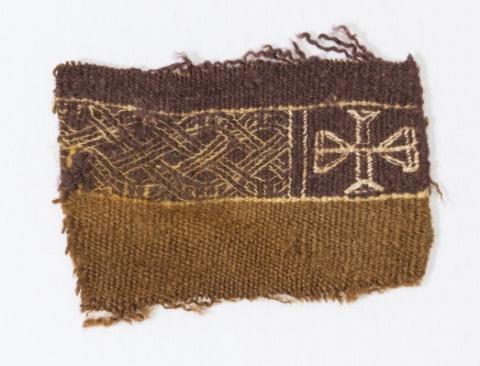Textile Fragment with Greek Cross and Interlacing Motif
Textile Fragment with Greek Cross and Interlacing Motif
Late Antique / Byzantine / Early Islamic, 2nd-9th century CE
height: 2.75" | width: 4"
This textile features a Greek cross and an interlacing pattern, an apotropaic motif, in white. Half of the fragment is dyed purple.
Hallie Ford Museum of Art, gift of the Arthur M. Sackler Foundation, accession no. 2015.030.007
Sara Crawford, Medieval Portland Capstone Student, 2016
This textile is likely a piece of a tunic made from linen with in-woven wool decorations.[1] It came from a burial site, preserved intact due to Egypt's climate and the continued practice of embalming their dead.[2] However, dating the piece is very difficult due to the nature of its retrieval, taken without recording its context.[3] Often, Coptic tunics were woven in one piece, with an opening for the head, and simply stitched together on the sides, forming a drape reminiscent of a toga.[4] They were decorated with strips of colored ornamentation, known as the clavus, of which this is a piece.[5] Modern Christian religious garments feature a similar use of the clavus.[6] It features red wool and naturally colored linen. Red was a common color, usually made from madder.[7]
A cross is woven into one end, which was likely the bottom of the clavus. The cross is a Greek cross, with all sides of equal length. Opposite to that is a fascinating knotted pattern, also known as interlacing.[8] It appears to have been done using the technique called the Soumak weave, which is a form of embroidery where an extra thread is threaded over the actual weave during the weaving process.[9] This creates a secondary, thinner pattern that is highlighted over the actual weave. This piece's interlace, or knotted, pattern is reminiscent of the weave itself and was likely planned before the weaving began and created on the loom along with the rest of the piece.[10]
Notes
[1] Elsje Janssen, “Coptic Textiles in the Rijksmuseum,” The Rijksmuseum Bulletin 61, no. 3 (2013): 228; Christopher J. Mazza, "Conservation of a 4th Century Coptic Fragment" (master's thesis, S.U.N.Y. Fashion Institute of Technology, 2015), 8; Ludmila Kybalova, Coptic textiles, trans. Till Gottheiner (London: Paul Hamlyn Ltd, 1967), 34, 39.
[2] Mazza, “Conservation of a 4th Century Coptic Fragment,” 8; Kybalova, Coptic textiles, 33.
[3] “Late Antique Textile Fragments,” Late Antique Textile Fragments, n.d., in Academic Commons, Willamette University, accessed October 17, 2016, http://libmedia.willamette.edu/hfma/omeka/exhibits/show/late-antique-textile-fragments; Mark Van Strydonck, Antonie De Moor, and Dominique Bénazeth, “14C Dating Compared to Art Historical Dating of Roman and Coptic Textiles from Egypt,” Radiocarbon 46, no. 1 (2004): 231; Janssen, “Coptic Textiles in the Rijksmusem,” 228.
[4] Margaret Seagroatt, Coptic Weaves: Notes on the collection of Coptic Textiles in the Merseyside County Museums (St. Helens, ENG: Wood Westworth & Co. Limited, 1978), 3; Kybalova, Coptic textiles, 34.
[5] Seagroatt, Coptic Weaves, 3; Kybalova, Coptic textiles, 34.
[6] Kybalova, Coptic textiles, 34.
[7] Kybalova, Coptic textiles, 40; Seagroatt, Coptic Weaves, 7.
[8] Kybalova, Coptic textiles, 43.
[9] Seagroatt, Coptic Weaves, 17. Kybalova, Coptic textiles, 43.
[10] Kybalova, Coptic textiles, 41.
Bibliography
Janssen, Elsje. “Coptic Textiles in the Rijksmuseum.” The Rijksmuseum Bulletin 61, no. 3 (2013): 226-249.
Kybalova, Ludmila. Coptic textiles. Translated by Till Gottheiner. London: Paul Hamlyn Ltd, 1967.
Late Antique Textile Fragments. n.d. in Academic Commons, Willamette University. Accessed October 17, 2016. http://libmedia.willamette.edu/hfma/omeka/exhibits/show/late-antique-textile-fragments.
Mazza, Christopher J. “Conservation of a 4th Century Coptic Fragment.” Master's thesis, S.U.N.Y. Fashion Institute of Technology, 2015.
Seagroatt, Margaret. Coptic Weaves: Notes on the collection of Coptic Textiles in the Merseyside County Museums. St. Helens, ENG: Wood Westworth & Co. Limited, 1978.
Strydonck, Mark Van, Antonie De Moor, and Dominique Bénazeth. “14C Dating Compared to Art Historical Dating of Roman and Coptic Textiles from Egypt.” Radiocarbon 46, no. 1 (2004): 231-244.

